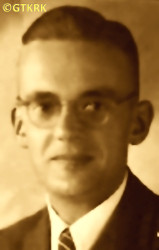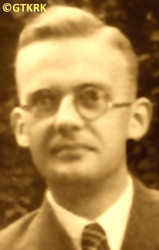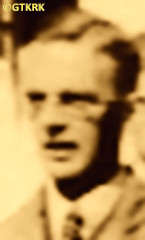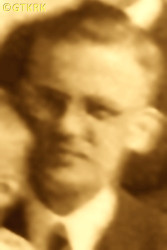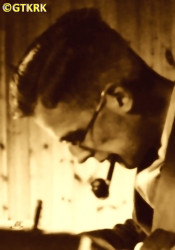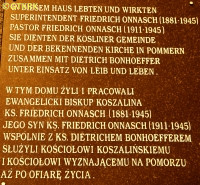Roman Catholic
St Sigismund parish
05-507 Słomczyn
85 Wiślana Str.
Konstancin deanery
Warsaw archdiocese, Poland
full list:
displayClick to display full list

searchClick to search full list by categories
wyświetlKliknij by wyświetlić pełną listę po polsku

szukajKliknij by przeszukać listę wg kategorii po polsku

Martyrology of the clergy — Poland
XX century (1914 – 1989)
personal data
surname
ONNASCH
forename(s)
Frederick Charles Günter (pl. Fryderyk Karol Günter)
forename(s)
versions/aliases
Frederick Karl Günter (pl. Friedrich Karl Günter)
function
pastor
creed
Lutheran Church LUmore on
en.wikipedia.org
[access: 2014.09.21]
nationality
German
date and place
of death
04.03.1945

Koszalintoday: Koszalin city pov., West Pomerania voiv., Poland
more on
en.wikipedia.org
[access: 2022.01.28]
details of death
After the national–socialist NSDAP party came to power in Germany in 1933, joined — as his father, Friedrich Albert Onnasch — the so‐called Confessing Church (Germ. Bekennende Kirche), founded in 1934.
On 28.09.1937, as inspector of ministry seminary in Zdroje–Szczecin, received an order issued by national–socialist political police Gestapo to close the institution.
On 19.11.1937 arrested.
Held in Szczecin prison.
On 20.12.1937 released.
In 01.1945, during Russian winter offensive of 1945 leading to the end of military hostilities of the World War II, started by German and Russian invasion of Poland in 09.1939, moved with his family to Koszalin.
Refused to leave the town after German authorities issued an evacuation order due to approaching Russians.
On the day the Russians captured the town (at the end of the so‐called the Chojnice–Koszalin operation, which was part of a larger Russian East Pomeranian offensive, carried out on 10.02.1945 – 04.04.1945) dragged out of the basement where he hid with his family, tortured and shot by the Russian soldiers.
cause of death
murder
perpetrators
Russians
sites and events
Ribbentrop‐MolotovClick to display the description
date and place
of birth
02.05.1911

Lobetaltoday: district of Bernau bei Berlin, Barnim dist., Brandenburg state, Germany
more on
de.wikipedia.org
[access: 2023.04.02]
presbyter (holy orders)
ordination
05.04.1936

SzczecinDrzetowo neighborhood
today: Szczecin city pov., West Pomerania voiv., Poland
more on
en.wikipedia.org
[access: 2023.04.02]
positions held
1940 – 1945
administrator — Szczecintoday: Szczecin city pov., West Pomerania voiv., Poland
more on
en.wikipedia.org
[access: 2021.12.18] ⋄ Bruderrat (Eng. Council of Brothers), Evangelische Kirche der Altpreußischen Union (pl. Evangelical Church of Old Prussian Union)
1937 – 1940
resident — Koszalintoday: Koszalin city pov., West Pomerania voiv., Poland
more on
en.wikipedia.org
[access: 2022.01.28] ⋄ Holy Mary LU parish — inspector of the local „Bruderhaus” community, cultivating spiritual life (Lat. vita communis); also: Evangelical Koszalin region assisntant preacher
1937
resident — ZdrojeFinkenwalde
today: neighborhood in Szczecin, Szczecin city pov., West Pomerania voiv., Poland
more on
en.wikipedia.org
[access: 2023.04.02] ⋄ Pastor Dietrich Bonhoeffer's Preachers Seminary, Zingsthof Retreat Center — inspector of the Preaching Seminary; also: assistant preacher in Podejuchy (today: Podjuchy, neighborhood in Szczecin)
till 1937
minister — ZdrojeFinkenwalde
today: neighborhood in Szczecin, Szczecin city pov., West Pomerania voiv., Poland
more on
en.wikipedia.org
[access: 2023.04.02] ⋄ Pastor Dietrich Bonhoeffer's Preachers Seminary, Zingsthof Retreat Center — member of the „Bruderhaus” community, cultivating spiritual life (Lat. vita communis)
c. 1936
student — ZdrojeFinkenwalde
today: neighborhood in Szczecin, Szczecin city pov., West Pomerania voiv., Poland
more on
en.wikipedia.org
[access: 2023.04.02] ⋄ Pastor Dietrich Bonhoeffer's Preachers Seminary, Zingsthof Retreat Center
c. 1935
student — Zingsttoday: Vorpommern‐Rügen dist., Mecklenburg‐Vorpommern state, Germany
more on
en.wikipedia.org
[access: 2023.04.02] ⋄ Pastor Dietrich Bonhoeffer's Preachers Seminary, Zingsthof Retreat Center
1934 – 1935
apprentice — Ferdinandshoftoday: Vorpommern‐Greifswald dist., Mecklenburg‐Vorpommern state, Germany
more on
en.wikipedia.org
[access: 2023.04.02] ⋄ LU parish
1933 – 1934
apprentice — Główczycetoday: Główczyce gm., Słupsk pov., Pomerania voiv., Poland
more on
en.wikipedia.org
[access: 2023.04.02] ⋄ LU parish
1930 – 1933
student — Erlangentoday: Erlangen urban dist., Middle Franconia reg., Bavaria state, Germany
more on
en.wikipedia.org
[access: 2023.03.24] ⋄ Department of Theology, Friedrich–Alexander–Universität (Eng. Friedrich–Alexander University) — studies crowned with the first „pro venia concionandi” exam before the Church Examination Board
1929 – 1930
student — Tübingentoday: Tübingen dist., Tübingen reg., Baden‐Württemberg state, Germany
more on
en.wikipedia.org
[access: 2022.07.16] ⋄ Evangelical Theology Department, Eberhard Karl University
from 1939
married — three children
others related
in death
BRUNClick to display biography Ginter, HELDTClick to display biography Charles Henry, MASSOW vonClick to display biography Bertha, ONNASCHClick to display biography Frederick Albert
sites and events
descriptions
Ribbentrop‐Molotov: Genocidal Russian‐German alliance pact between Russian leader Joseph Stalin and German leader Adolf Hitler signed on 23.08.1939 in Moscow by respective foreign ministers, Mr. Vyacheslav Molotov for Russia and Joachim von Ribbentrop for Germany. The pact sanctioned and was the direct cause of joint Russian and German invasion of Poland and the outbreak of the World War II in 09.1939. In a political sense, the pact was an attempt to restore the status quo ante before 1914, with one exception, namely the „commercial” exchange of the so‐called „Kingdom of Poland”, which in 1914 was part of the Russian Empire, fore Eastern Galicia (today's western Ukraine), in 1914 belonging to the Austro‐Hungarian Empire. Galicia, including Lviv, was to be taken over by the Russians, the „Kingdom of Poland” — under the name of the General Governorate — Germany. The resultant „war was one of the greatest calamities and dramas of humanity in history, for two atheistic and anti‐Christian ideologies — national and international socialism — rejected God and His fifth Decalogue commandment: Thou shall not kill!” (Abp Stanislav Gądecki, 01.09.2019). The decisions taken — backed up by the betrayal of the formal allies of Poland, France and Germany, which on 12.09.1939, at a joint conference in Abbeville, decided not to provide aid to attacked Poland and not to take military action against Germany (a clear breach of treaty obligations with Poland) — were on 28.09.1939 slightly altered and made more precise when a treaty on „German‐Russian boundaries and friendship” was agreed by the same murderous signatories. One of its findings was establishment of spheres of influence in Central and Eastern Europe and in consequence IV partition of Poland. In one of its secret annexes agreed, that: „the Signatories will not tolerate on its respective territories any Polish propaganda that affects the territory of the other Side. On their respective territories they will suppress all such propaganda and inform each other of the measures taken to accomplish it”. The agreements resulted in a series of meeting between two genocidal organization representing both sides — German Gestapo and Russian NKVD when coordination of efforts to exterminate Polish intelligentsia and Polish leading classes (in Germany called «Intelligenzaktion», in Russia took the form of Katyń massacres) where discussed. Resulted in deaths of hundreds of thousands of Polish intelligentsia, including thousands of priests presented here, and tens of millions of ordinary people,. The results of this Russian‐German pact lasted till 1989 and are still in evidence even today. (more on: en.wikipedia.orgClick to attempt to display webpage
[access: 2015.09.30])
sources
personal:
www.przyjaciele.koszalin.plClick to attempt to display webpage
[access: 2013.05.19], www.grieppommer.deClick to attempt to display webpage
[access: 2013.05.19], www.grieppommer.deClick to attempt to display webpage
[access: 2019.12.01], de.wikipedia.orgClick to attempt to display webpage
[access: 2019.12.01]
original images:
www.grieppommer.deClick to attempt to display webpage
[access: 2019.12.01], www.grieppommer.deClick to attempt to display webpage
[access: 2019.12.01], www.grieppommer.deClick to attempt to display webpage
[access: 2019.12.01], www.grieppommer.deClick to attempt to display webpage
[access: 2019.12.01], grieppommer.deClick to attempt to display webpage
[access: 2014.09.21], commons.wikimedia.orgClick to attempt to display webpage
[access: 2019.12.01]
LETTER to CUSTODIAN/ADMINISTRATOR
If you have an Email client on your communicator/computer — such as Mozilla Thunderbird, Windows Mail or Microsoft Outlook, described at WikipediaPatrz:
en.wikipedia.org, among others — try the link below, please:
LETTER to CUSTODIAN/ADMINISTRATORClick and try to call your own Email client
If however you do not run such a client or the above link is not active please send an email to the Custodian/Administrator using your account — in your customary email/correspondence engine — at the following address:

giving the following as the subject:
MARTYROLOGY: ONNASCH Frederick Charles Günter
To return to the biography press below:
 Click to return to biography
Click to return to biography








